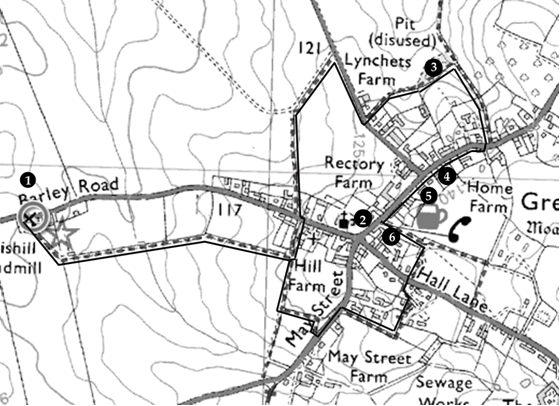A Circular Walk from Little Chishill Windmill
by
Lorraine Brand
4.5km. Approx 1hr
Lorraine Brand
4.5km. Approx 1hr
Start
Notes- sourced from Unwin P ‘Old Windmills of Chishill’ and Prior L.E.A. ‘Great and Little Chishill’ – a Tale of Two Villages This walk is about 4.5 km and takes one to one and a half hours. The clunch pit area gets slippery after extended periods of rain. Park in the windmill car park.
This walk is about 4.5 km and takes one to one and a half hours. The clunch pit area gets slippery after extended periods of rain. Park in the windmill car park.
With the windmill [1] on your right and Postmill house on your left, walk down the mown footpath facing you. This very soon turns left. After 200m, cross a footbridge and head towards St Swithun’s church [2]. At the corner of the field and at a footpath ‘t’ junction, turn left down a track between some houses. After about 100m you reach Barley Rd.
Cross the road and turn left for a short distance taking the footpath on your right. [Pudgell] Walk straight on between more houses. The footpath soon opens up to fields and splendid views on your left and trees to your right. Carry on, bearing right at a junction with a bridleway on the left until you reach New Road with a water board pumping station on your right. Turn right.
When you reach a small, circular 30 mph sign on your right [past the larger pair of 30mph signs], cross the road and follow the footpath between two houses straight ahead. After about 150m the path bears right into a wooded area which contains an old clunch pit [3]
Follow the downhill footpath to a ‘t’ junction, turn right and after a while you will eventually reach Heydon road.
Turn right onto this road and you will soon see the village lock-up [4] and then the Pheasant pub [5] on your left. Shortly after the pub and just before the telephone box a footpath on the left takes you across the Plaistow [6] with its millennium stone.
At the end of the Plaistow turn sharp right and walk along the right hand edge of Bull meadow [with a view of the cricket pavilion and village hall on the left] until you reach Hall Lane.
Cross this road and opposite you there is a footpath between some houses. Follow this path watching out for a signposted ‘right’ down a narrow footpath with back gardens on both sides. This footpath eventually leads to a field on your left and hedge on your right. The footpath turns right at the corner of this field. When you reach May St turn left.
After about 100m and at the footpath sign turn right up some steps. At the top of the steps turn right again and walk along a footpath on the field edge until you come to a footpath ‘t’ junction. Turn right and at the corner of the field turn left back towards the windmill.
Windmill [1] First officially mentioned in 1592, but it is believed that a windmill has been here for much longer. Last used in 1951, restored in 1965, listed as an historical monument and open to the public, it is one of only five similar examples of postmill remaining in Britain. A postmill is a box-like timber structure with sails, mounted on an upright oak post around which it can turn to face the wind.
St Swithun’s church [2] Built of flint and flint and rubble with the tower originally topped by a small spire, the church was founded in 1136 by Geffrey de Magnaville, but almost certainly there would have been a place of worship there before, positioned as it was, with Deep Well House just behind it. Wells, springs, high ground and ash trees were places of religious significance. A fire in 1789 destroyed a lot of the village. St Swithun’s roof and belfry floor were alight and one of the bells was cracked. 150 years before the fire, Cromwell’s troops knocked out most of the stained glass. Legend has it that some of the stained glass lies buried nearby. The five bells were rung for the first time in 23 years on September the 12th 1998 as the beginning of a village project to get them and the bell tower repaired in time to ring in the new millennium.
Clunch [3] A traditional building material and a term which encompasses a wide variety of materials, often locally variable. It is predominantly chalk/clay based and bedded in mortar to form walls.
Village lock-up [4] Lock-ups were used to detain breakers of the peace or felons until they could be taken before the magistrate. It was probably erected at parish expense in the 19th century.
The Pheasant pub [5] – a free house dating back to1635, and formerly known as the ‘Plough'.
Plaistows [6] Pieces of land found very close to churches and used for the game of camping or camp-ball - described as a blend of football and handball. This was played for centuries in Norfolk, Suffolk, Cambridgeshire and Essex. Great Chishill plaistow was also used for the practice of archery, a sport important in those days for the defence of the realm.